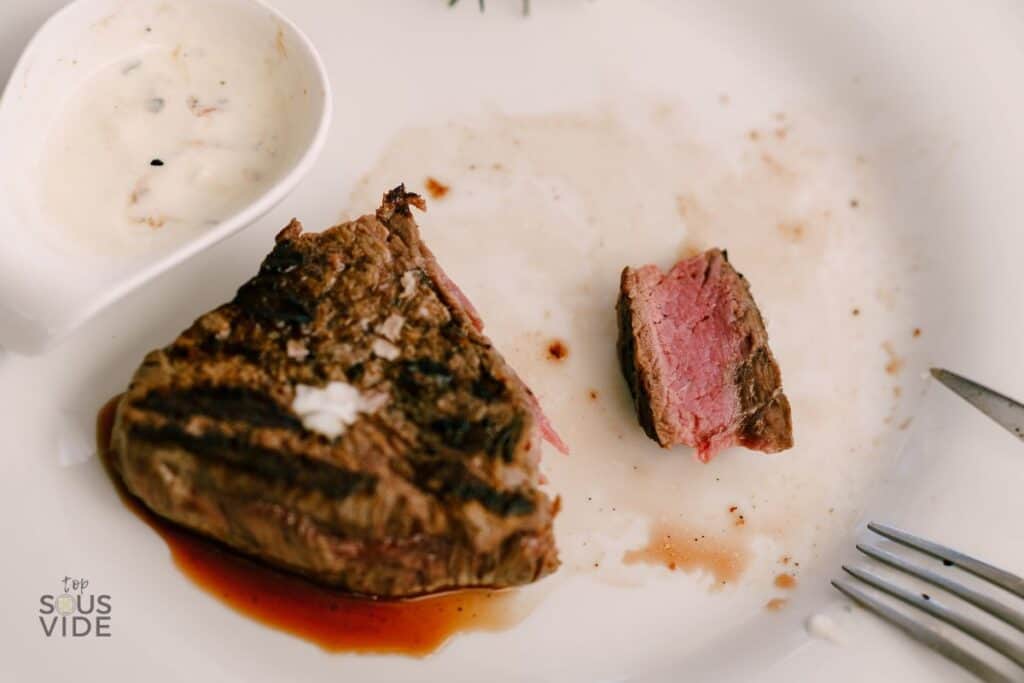It can be a startling experience to slice into a hot steak right off the grill only to realize that it’s oozing… What is that mysterious red stuff in steak? Is it blood? Is it safe to eat?
The “red stuff” isn’t actually blood. It’s a combination of water and myoglobin, which is a protein found in the muscle tissue of the meat. And yes, it’s safe to eat.
In this article, I’ll break down the science of myoglobin into simple and easy-to-understand explanations. You’ll learn the role that myoglobin plays in a red-rare steak or if there are any traces of blood in raw beef. So, let’s get into it!

Table of Contents
The Red Stuff in Steak Is NOT Blood
You can rest assured that the “red stuff” seeping out of your steak doesn’t mean it’s spoiled, and it definitely isn’t blood. Scientists refer to this phenomenon as “weep” or “purge.” While it may look like blood, it’s actually just a harmless combination of water and iron known as myoglobin.
Myoglobin contains iron molecules that give it its distinctive red color. As the meat cooks, the iron molecules oxidize and become darker. You can see this at play when you compare a bright red rare steak to a brownish-gray well-done one.
Resting your steak after it’s cooked is the key to minimizing purge.
During the cooking process, the muscle tissue constricts and forces the myoglobin out of the tissue to sit between the fibers. So if you were to remove the steak from the grill and immediately cut into it, all those red juices would pour out of the meat. In the end, you’ll have a dry and chewy steak.
Instead, you should always rest any meat for at least 5 minutes before cutting it.
The rest allows the myoglobin time to reabsorb and redistribute into the muscle. That means less weeping on the plate, and you get to enjoy all the work that went into preparing that tender and juicy sous vide steak.
Myoglobin vs Blood
While myoglobin and blood are both proteins, they differ in structure and function.
Myoglobin is a protein found in muscle tissue that binds oxygen for storage and transport. When steak or ground beef is cooked, the myoglobin undergoes a series of chemical changes that alter its color. Thus, giving steak its characteristic brownish-red hue.
On the other hand, blood is the liquid that circulates throughout the circulatory system of animals. While a small amount of blood may be present in raw meat, it is typically drained during the butchering process.
Any red liquid that appears in raw meat packaging or seeps out of a cooked steak is just a mixture of water and dissolved myoglobin proteins, not blood.
But Does Raw Meat Have Blood in It?
The red liquid that you see at the bottom of the styrofoam packaging isn’t blood, and neither is the red stuff weeping from a cooked steak.
According to the USDA, blood is removed from beef during slaughter, and only trace amounts remain within the muscle tissue. The trace amounts of blood provide iron-rich compounds to the beef and enhance the steak’s flavor.
However, you will notice myoglobin, a red liquid resembling blood, on your steak plate. It’s not blood, but it does contain iron. While the presence of myoglobin may turn some people off, it’s important to remember that it’s virtually tasteless, harmless, and won’t make you sick.
The Bottom Line
Don’t worry—the red liquid accumulating on your steak plate is not blood. It’s actually a mixture of water and an iron-rich protein called myoglobin.
Myoglobin is found in the muscle tissue of animals. So, when you cut into a steak, you sever the muscle fibers, which release some of the myoglobin. That’s the liquid you notice at the bottom of the styrofoam butcher packaging or running out of a sliced, cooked steak.
Just about all the blood is drained from the meat during the butchering process, so only trace amounts remain in the muscle tissue. So all it does is create the delicious texture and steak flavor that we all know and love.
Now that we know there’s nothing to worry about—that myoglobin is natural, harmless, and safe to eat—it’s time to set up the sous vide station. So get ready to dine on a tender, juicy ribeye!
Red Juice in Steak FAQs
Myoglobin is good for you. It’s an excellent source of dietary iron. It stores oxygen in muscle cells and acts like hemoglobin, keeping oxygen in blood cells.
It’s not blood that’s running out of your steak. It’s called “purge,” and it’s just water and myoglobin. The red liquid is harmless and almost tasteless. It’s actually what makes a rested steak tender and juicy.
The red juice that comes out of a steak isn’t blood. Instead, it’s a combination of water and myoglobin. Myoglobin is a protein that’s found in muscle tissue, and it’s responsible for giving a rare steak its bright red color.

